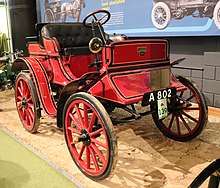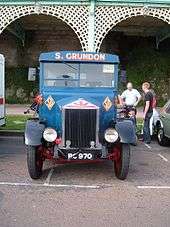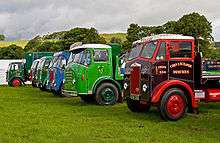Albion Motors
Albion Motors was a Scottish automobile and commercial vehicle manufacturer.
 | |
| Industry | Automotive |
|---|---|
| Successor | Leyland |
| Founded | 1899 |
| Founder | Norman Fulton John Henderson Thomas Murray |
| Defunct | 1972 |
| Headquarters | Glasgow, Scotland, UK |
| Products | Buses Cars Commercial vehicles |
| Parent | British Leyland |
Founded in 1899, Albion Motors was purchased by Leyland Motors in 1951. Vehicles continued to be manufactured under the Albion brand until 1972, after which they continued to be produced, but were sold under the Leyland brand. Vehicle production at the former Albion factory in the Scotstoun area of Glasgow, Scotland, continued until 1980.
History










Originally known as Albion Motor Car Company Ltd, the company was founded in 1899 by Thomas Blackwood Murray and Norman Osborne Fulton (both of whom had previously been involved in Arrol-Johnston). Murray's father, John Lamb Murray mortgaged the Heavyside estate in Biggar, South Lanarkshire, to provide the initial capital.[1] They were joined a couple of years later by John F Henderson who provided additional capital. The factory was originally on the first floor of a building in Finnieston Street, Glasgow and had only seven employees. In 1903 the company moved to new premises in Scotstoun.[2][3]
In April 1931, the Albion Motor Car Company Ltd was renamed Albion Motors Limited. In 1951, Albion was purchased by Leyland Motors, which then became part of the British Leyland Motor Corporation in 1968.[2][4][5][6] Production of the Chieftain, Clydesdale and Reiver trucks and of the Viking bus models continued. In 1969, the company took over the neighbouring Coventry Ordnance Works on South Street, which it used for truck component manufacture. British Leyland eliminated the Albion name in 1972 with the products continuing to be built at the same factory under the Leyland brand.[6][7] In 1980, vehicle production at the former Albion factory ceased, moving to the British Leyland plant at Bathgate, however component manufacturing continued.[8]
British Leyland became Rover Group between 1986 and 1997 the component manufacturing plant became part of Leyland DAF, the newly formed British arm of the Anglo-Dutch company DAF NV, formed by the merger of Rover Group's Leyland Trucks division and the Dutch DAF Trucks company.[3][6]
Following the collapse of DAF in 1993, Leyland DAF went into receivership, and the truck components business in Scotstoun was subject to a management buyout and transferred to a newly created company called Albion Automotive.[3][9] In 1998, Albion Automotive was acquired by American Axle & Manufacturing Company of Detroit.[10][11] The new company manufactures axles, driveline systems, chassis systems, crankshafts and chassis components.[12]
Passenger car manufacturing
In 1900 the company built its first motor car, a rustic-looking dogcart made of varnished wood, powered by a flat-twin 8hp engine with gear-change by "Patent Combination Clutches" and solid tyres.
In 1903 Albion introduced a 3115 cc 16 hp vertical-twin, followed in 1906 by a 24 hp four. One of the specialities the company offered was solid-tyred shooting-brakes. The last private Albions were powered by a 15 hp monobloc four of 2492 cc.
Passenger car production ceased in 1915 but in 1920 the company announced that estate cars were available again based on a small bus chassis, it is not known if any were actually made.
Car models
- Albion 8 (1900–1904) 2080 cc twin-cylinder
- Albion 12 (1900–1906) 2659 cc twin-cylinder
- Albion 16 (1905–1913) 3141 cc twin-cylinder
- Albion 24/30 (1906–1912) 3164 cc 4-cylinder
- Albion 15 (1912–1915) 2492 cc 4-cylinder
Commercial vehicle production
Although the manufacture of motor cars was the main industry in the first ten years of its existence, it was decided in 1909 to concentrate on the production of commercial vehicles. During World War I they built for the War Office large quantities of 3 ton trucks powered by a 32 hp engine using chain drive to the rear wheels. After the war many of these were converted for use as charabancs.
Trucks and buses (single and double deckers) were manufactured in the Scotstoun works until 1980 (1972 for complete vehicles). The buses were exported to Asia, East Africa, Australia, India and South Africa. Almost all Albion buses were given names beginning with "V", these models being the Victor, Valiant, Viking, Valkyrie, and Venturer.
Lorry models
- CX22S Heavy artillery tractor.[13]
- WD66N (only 9 built).[13]
- WD.CX24 Tank transporter
- Chieftain (1948)
- Clansman
- Claymore (1954-1966)
- Clydesdale
- Reiver
Albion also made the Claymore with the 4 speed gearbox, The Reiver was a six wheeler. The Chieftain had a 6 speed gearbox, 6th being an overdrive gear, with a worm and wheel rear axle.
Bus production
The earliest buses were built on the A10 truck chassis with two being delivered to West Bromwich in 1914. Newcastle upon Tyne also took double deckers around this time, but Albion did not produce a purpose-built double deck chassis until 1931.
In 1923 the first dedicated bus chassis was announced derived from the one used on the 25 cwt truck but with better springing. Bodies seating from 12 to 23 passengers were available. A lower frame chassis, the Model 26, with 30/60 hp engine and wheelbases from 135 inches (3,400 mm) to 192 inches (4,900 mm) joined the range in 1925. All the early vehicles had been normal control, with the engine in front of the driver but in 1927 the first forward control with the engine alongside the driver was announced as the Viking allowing 32 seats to be fitted. Diesel engines, initially from Gardner, were available from 1933. The first double deck design was the Venturer of 1932 with up to 51 seats. The CX version of the chassis was launched in 1937 and on these the engine and gearbox were mounted together rather than joined by a separate drive shaft. Albion's own range of diesel engines was also made available.
After World War II, the range was progressively modernised and underfloor engined models were introduced with two prototypes in 1951 and production models from 1955 with the Nimbus.
With the Leyland take over the range was cut back. The last Albion double decker was the 1961 Lowlander and that was marketed in England as a Leyland, and the last design of all was the Viking, re-using an old name.
Bus models
- Model 24 (1923–1924) First purpose built Albion bus chassis
- Viking 24 (1924–1932) Various wheelbases from 10 ft 9 in (3.28 m) to 16 ft 3 in (4.95 m) Front wheel brakes from 1927. Six cylinder engines available in Viking Sixes.
- Valkyrie (1930–1938) Forward control. 5 litre engine, 6.1 litre from 1933, 7.8 litre optional from 1935. Mainly sold as coaches.
- Valiant (1931–1936) Mainly sold to the coach market.
- Victor (1930–1939) Normal or forward control. 20 or 24 seater.
- Venturer (1932–1939) Albions first double decker. 51, later 55 seats. 3 axle version, the Valorous made in 1932, only one produced.
- Valkyrie CX (1937–1950) Engine and gearbox in-unit.
- Venturer CX (1937–1951) Double decker.
- Victor FT (1947–1959) Lightweight single decker
- Valiant CX (1948–1951) Mostly sold to coach operators.
- Viking CX (1948–1952) Mainly sold to the export market.
- KP71NW (1951) Underfloor engined chassis with horizontally-opposed eight cylinder engine; 2 built.
- Nimbus (1955–1963) Underfloor engine.
- Aberdonian (1957–1960) Underfloor engine.
- Royal Scot (1959) 15.2 litre underfloor engined 6×4 dirt-road bus. 20 built for South African Railways.
- Victor VT (1959–1966) Front engined, derived from Chieftain truck chassis.
- Clydesdale (1959–1978) Export model built on truck chassis.
- Talisman TA (1959) 9.8 litre front engined 6x4 dirt-road bus. 5 built for Rhodesian Railways.
- Lowlander (1961–1966) Double decker. 18 ft 6 in (5.64 m) wheelbase. LR7 had air rear suspension.
- Viking VK (1963-1980) Mainly exported. Leyland O.370 O:400, O:401 engines. VK 41,55 were front engined; VK43,45,49,57,67 models were rear engined, Australian market had optional AEC AV505 engines.
- Valiant VL (1967–72) Similar to rear-engined Vikings but with tropical cooling unit as on VK45 and axles from Clydesdale.
Firearms production
During World War II, Albion Motors manufactured Enfield No 2 Mk I* revolvers to aid the war effort. By 1945, 24,000[14] Enfield No 2 Mk I* revolvers were produced by Albion (and subsequently, Coventry Gauge & Tool Co.)
In popular culture
- Mark Knopfler's song, "Border Reiver", the first cut on his 2009 release, "Get Lucky", contains direct references "My Scotstoun lassie", "She's an Albion" and "Sure as the Sunrise"
References
- "1891 JOHN LAMB MURRAY Architect (1838-1908) Heavyside, Biggar, Lanarkshire". eBay. Retrieved 27 July 2017.
- Companion to Road Passenger Transport History. Walsall: Roads & Road Transport History Association. 2013. pp. 36/37. ISBN 9780955287633.
- Albion National Road Transport Hall of Fame
- Leyland Motors Limited Railway Gazette 27 July 1951 page 112
- Leyland - Albion :Most Powerful Undertaking Commercial Motor 25 January 1952
- "Albion Works". The Glasgow Story. Retrieved 9 October 2018.
- No more Albions - they become Leylands Commercial Motor 1 September 1972
- LV on quality street Commercial Motor 22 November 1980
- Component and axle plants merge Commercial Motor 2 December 1993
- Briefs Commercial Motor 15 October 1998
- "American Axle takeover puts Albion into premier league". The Engineer.
- AAM Europe creates new centre of excellence in Glasgow Scottish Enterprise 2 October 2012
- Ware 2012, p. 193.
- Pistols of the World, 4th ed. Ian Hogg & John Walter
Other sources
- Michael Sedgwick, "Albion", in G.N. Georgano, ed., The Complete Encyclopedia of Motorcars 1885-1968 (New York: E.P. Dutton and Co., 1974), pp. 32.
- Adams & Milligan, Albion of Scostoun, Paisley 1999
- Ware, P (2012). The illustrated guide to military vehicles. Wigston: Hermes House. ISBN 0-85723-953-8.CS1 maint: ref=harv (link)
External links
| Wikimedia Commons has media related to Albion Motors. |